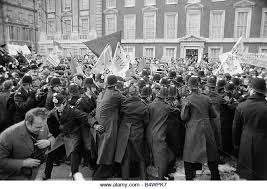
Two anti-Vietnam War protests in London in 1968 led to the formation of the Special Demonstrations Squad.
“Give me £1 million and 10 men and I can deal with the problem for you”. Those were the words supposedly spoken by chief inspector Conrad Dixon of Special Branch in September 1968. The problem was the escalation in political protest against the Vietnam War in particular and capitalism in general. The Labour government of Harold Wilson agreed and funded this new unit, known at first as the Special Operations Squad – then from 1972 as the Special Demonstrations Squad – directly from the treasury.
The solution Dixon proposed was police infiltration of political and protest groups of a type never seen before. Officers would become activists and live amongst that milieu for years. They would change their appearance to fit in, be equipped with fake ID, adopt the habits and lifestyle of their “targets”and never set foot in a police station. They would even spend most of their time away from their families.
The only officer they would see was a handler to report back intelligence they had gathered. Every so often all undercovers would gather in a safe house somewhere in London for a bit of team building. The book Undercover by Rob Evans and Paul Lewis gives a flavour of these gatherings:
It was standard practice…for the police officers to remain in their undercover roles throughout. It led to some bizarre encounters. A bearded anarchist enraged in angry debate with a fascist skinhead. Animal rights activists tried to persuade their colleagues to give up meat. Campaigners from rival left-wing groups would argue over the finer points Marxism.
From 1960-1980 Special Branch grew exponentially from about 225 to more than 1600 officers but the SDS never had more than 12 agents “in the field” and was so secret very few officers elsewhere in the Met knew it existed. When undercover-turned whistleblower Peter Francis joined in 1993, “three police officers were embedded in left-wing groups, two in the animal rights movement, two in right-wing groups and others in campaigns supporting causes such as Irish republicanism.”
There were also Special Branch units based in provincial police forces. As well as carrying out surveillance such as phone taps and opening mail, they too had undercover officers. It’s been estimated there were over 100 spycops during the SDS’ 40 year existence but we have no idea how many were were deployed regionally.
A tactic routinely employed by SDS agents – and also presumably in the regions – were the theft of dead children’s identities. A police report from 2013 stated 42 SDS officers used dead children’s names, 45 fictitious identities, and 19 were unknown. The practice of stealing identities seems to have largely dropped by the mid-1990s.
It appears most undercovers had sexual relationships with members of the groups they targeted. In some cases these were casual, in others they were longterm and intimate. One agent, Bob Lambert, fathered a child with an animal rights activist named Jacqui in the eighties. Like all SDS agents he disappeared abroad – claiming to be on the run from the police – and she never knew who he was for another 24 years. In October 2014 she received £425,000 in compensation. Soon afterwards seven women who had also been deceived into longterm relationships and had sued the Met received an apology and compensation.
In October 2006 the Met merged Special Branch with its anti-terrorist branch to form Counter Terrorism Command and the SDS closed in 2008. By then another secret state institution, the National Public Order Intelligence Unit, had been spying on campaigners for nearly a decade. Its agent Mark Kennedy infiltrated environmental and anti-capitalist groups for seven years until he was unmasked in 2010, leading to the unravelling of the spycops conspiracy
Leave a Reply